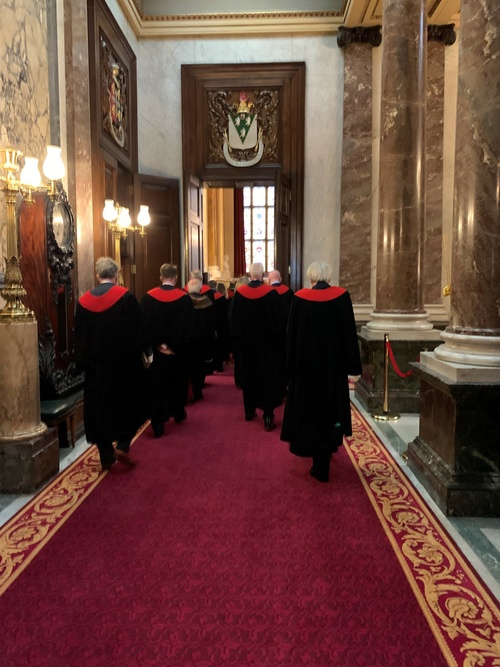HYBRID HANDOVER
7 JULY 2021

The final Court meeting of Bishop Stephen Platten’s year as Master was grand.
It was the company’s first hybrid Court meeting, followed by a hybrid Common Hall and a hybrid installation of the new Master. All this mixing of time and space and online and offline (ie reality) took place in the palatial splendour of the Goldsmiths’ Hall, with a confusion of masks and social distancing adding to the strangeness. But it was done, and done properly.
But before the ceremonial, the Court was told that the long-drawn-out negotiations with the Diocese of London over the Company’s use of St Martin-within-Ludgate were not yet completed. Two other organisations were reported as interested in licensing the rooms at the Church, and the Diocese was sticking to a proposed annual lease of £25,000 – £30,000 which the Master and Wardens Committee agreed was excessive, especially in the post-Covid world.
The Master said it was hoped that the Diocese would come back with an arrangement for the Church to be used occasionally. It would be a great pity if the Stationers could not use it at all. For the moment, though, the Company still had the use of the Church rooms.
Attention then turned to the Hall and its reconstruction. Court Assistant Paul Wilson is the Chairman of the Hall Project Executive Committee. He said that archaeological investigations of the site were still proceeding, and might take another two weeks. This would mean a delay of four months to the expected completion date of the Vison 350 project. As well as that, work to remove discovered buried asbestos on the site had just completed. It was not yet possible to assess the added costs of the delays.
Past Master Nigel Stapleton, the Chairman of the Vision 350 Steering Group, said that at this point only a small amount of the contingency fund (circa £70k) remained in the budget. It was – he said – a very small amount when we were only halfway through the project. He was also concerned that it might not be possible to use the Hall until May 2022, with an impact on the Company’s potential revenue from events.
The Company had a fixed price contract with the contractors but concern was expressed about the recent rapid rises in the price of raw materials in the construction industry.
Past Master Helen Esmonde reported on some of the options being considered by the Finishes committee. They would like to give the Court the option of telling the Stationers’ story in the new displays, she said.
The Master pointed out that it was the final meeting for Past Master Christopher McKane, a long-standing key member of the Court, to which he had contributed so much since joining the Court 21 years’ ago. He gave to PM McKane the warmest of thanks and the highest level of congratulations. In return, PM McKane paid tribute to Bishop Stephen for his year as Master is hard times, his 50 Zoom interviews – a genuine celebration of the Company’s diversity – and the Master’s wisdom, kindness and good humour.
And with that it was time for the annual Common Hall, the Installation Ceremony, and the celebration of the new Master Robert Flather. An engineer by training and profession (albeit in the printing and book production industry) he entertained us with the story of his Sheffield antecedents and his links with the Company of Cutlers in Hallamshire, including several Masters. Hybrid or not, his accession was a great occasion.
(A personal PS.) Now that we are again allowed to be out and about, it is of course fascinating to see a succession of other Companies’ Livery Halls. Very fine they are too, resplendent in the case of the Goldsmiths’. But there does not seem to be anything quite like the Stationers’: grandeur tempered with grace. It is absolutely fit for purpose, except that when the rebuilding is completed, it will be even fitter.